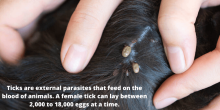By Dr. Heather Kovac
The Patient
Dixie, a 3 year old Cairn Terrier, came to see me for her regular annual check-up. She was doing very well at home and the owner had no concerns.
The Case
On physical examination, I found a live tick attached to the top of her head. It was hiding in the fur and could not be seen unless the hair was parted. It was about the size of a small raisin. Many times, owners think their dog has a mass on their skin when it is actually a tick.

Ticks are arachnids, not insects. They have 4 life stages (egg, larva, nymph, adult) and are external parasites that feed on the blood of animals. Adult female ticks can lay between 2,000 to 18,000 eggs at a time. The United States has 4 major types of ticks: brown dog ticks, American dog ticks, black legged ticks (deer tick), and lone star ticks. Ticks can carry and transmit diseases such as ehrlichia, anaplasma, bartonella, tularemia, Rocky Mountain spotted fever, and Lyme disease. Some tick borne diseases can also lead to secondary illnesses in dogs such as immune-mediated diseases like anemia (low red blood cells) and thrombocytopenia (low platelets). Plus, they are just gross!
Dogs pick up ticks from walking through plants where ticks are "questing." Ticks crawl up tall plants and sit patiently waiting for a host to walk past. They stand on their back legs with their front legs extended just hoping a tasty host will walk past and then they grab ahold of the fur or skin or clothing and crawl to an area where they take a bite. Once they bite, they do not let go, using their mouth parts to hold on to the host. They then take a blood meal and stay connected for several days. This is when disease transmission occurs.

To remove a tick off yourself or your dog, grasp it with a tweezer or forcep down as close to the skin as possible and pull straight out without twisting. Never use a match to try to burn it off. Please be sure it is a tick before trying to remove it! We have had some clients inadvertently remove skin tags or even nipples thinking it was a tick. You will see the legs of the tick and if it is alive, the legs will move when you touch it. After removal, smash the tick with a rock or other hard tool. Do not let it crawl away!
I was able to remove Dixie's tick easily and did not find any others on her body. We do not recommend testing for tick borne illnesses in healthy dogs because it can take months or even years for dogs to have positive test results and many will clear the infections on their own. We do however, screen dogs who are sick with low red blood cells or platelets for tick borne diseases.
The Treatment Plan
I recommended that Dixie start a tick preventative since we now know that she may be exposed to more ticks in her yard, at parks, or on trails in San Diego. The product we recommend is called Bravecto and it is administered as an oral chew (or topical) every 3 months. Many owners are misinformed about some other flea products, thinking that they also protect against ticks. Here are the antiparasiticide products we recommend for dogs and what they do:
Sentinel--taken orally once a month year round for all dogs no matter their lifestyle or age
*2 active ingredients:
- Lufenuron: insect growth regulator (IGR) that prevents flea eggs from hatching but does NOT kill adult fleas
- Milbemycin: heartworm prevention and treatment for intestinal worms such as roundworms, hookworms, and whipworms
Bravecto--taken orally or given topically every 3 months or seasonally for dogs 6 months of age and older
*1 active ingredient: Fluralaner: kills adult fleas and ticks
The Takeaway
Keeping your pet on a year-round parasite prevention plan is the best way to defend them against fleas and ticks and to protect your home from infestaion. If you are finding parasites on your pet or want to prevent them, please contact us to schedule an appointment.
The Drake Center for Veterinary Care is an AAHA-accredited animal hospital located in Encinitas, CA. The Drake Center loves being a source of information for all pet owners across the country however if you have any questions regarding pet care and do not live in Encinitas, CA or surrounding cities, we encourage you to contact your local veterinarian.
